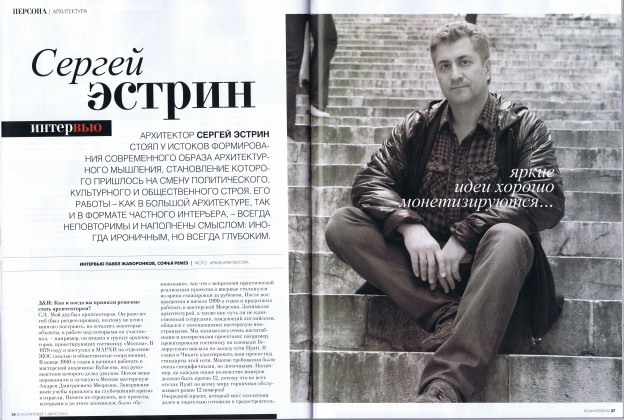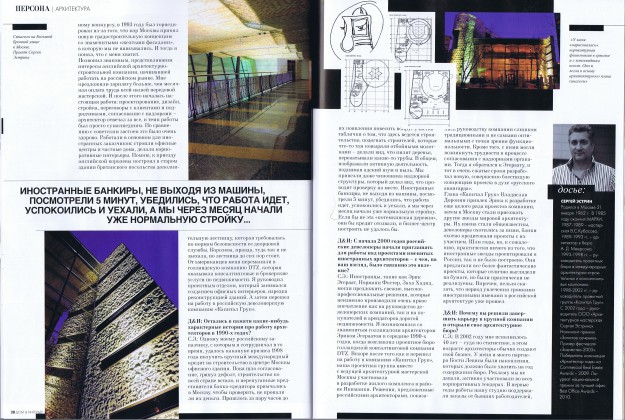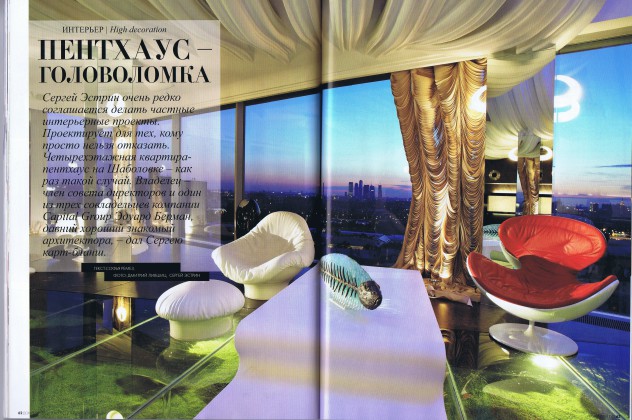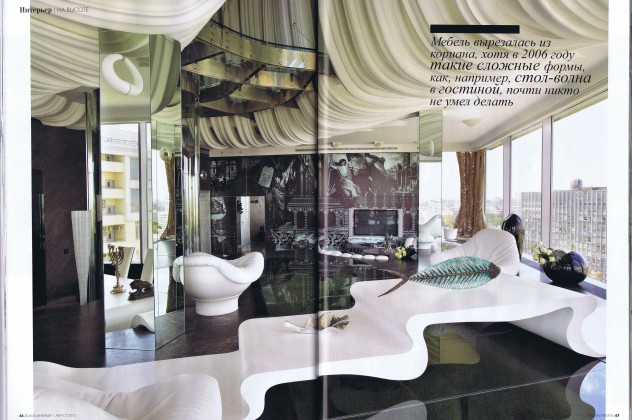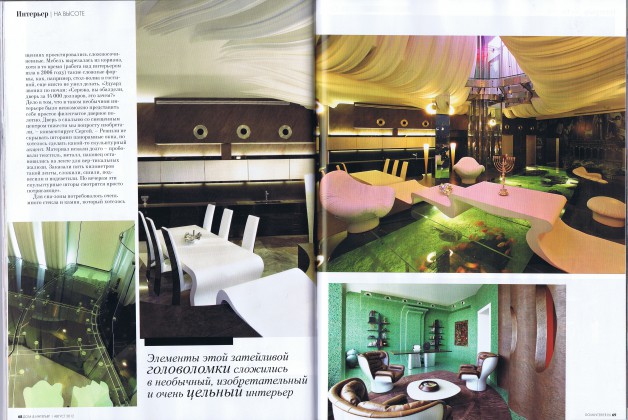Interview with Sergey Estrin: “Bright ideas are well atoned for”| Dom & Interior, 21.09.2011
Sergey Estrin is the engineer of architectural mentality modern image, brought about and established during political, cultural and social system alteration. His projects in urban as well as in private interior design format are always exceptional and full of meaning, sometimes ironical, but always profound. The founder of one of the Moscow leading architectural studios is acting as our guest editor for “revolutionary” issue of Done&Interier Magazine.
D&I: How and when have you decided to become an architect?
S.E.: My grandfather was an architect. He died early (victim of political repression), therefore couldn’t build much, but there are several properties co-designed by him. For example he was part of the Moscow Hotel design team. At home we still have his sketches. Unfortunately I haven’t met my grandfather personally, and till the end of seventies there was no information on victims of political repressions. My grandfather was graduate of Moscow University of Civil Engineers and liked to draw very much. So, as you see, family history disposes to choice of an artistic profession.
In 1979 I enrolled in Moscow Architectural University Residential and Public Buildings Brunch. In the University I have met professor Oltarzhevsky who comes from legendary architectural family. His uncle built Kiev Station, Oltarzhevsky himself graduated from Paris lycée and completed several works for UNESCO. I was very much impressed by this acquaintance.
Brief biography:
Born in Moscow 21st January 1962
In 1985 graduated from Moscow Architectural University
1987-1991 – A.D. Meerson architectural studio
1991-1998 – Head of Design Studio in international consulting and construction companies
1998 -2002 – Head of design group in Capital Group of companies
In 2002 founded private architectural studio
Golden Section Award nominee
Architecture 2005 Award winner
Architect of the year 2009 at Commercial Real Estate Awards
National Best Office Awards 2010 winner
D&I: At the time, how did you see your professional future?
S.E.: The understanding was a bit mixed up. At the end of each year we had internship in various studios and I could see that not that much was being built in the country. Construction took 15 to 20 years, therefore I was well rid of my illusions quite early.
D&I: By the time you have graduated from University the system has already collapsed.
S.E.: The state-guaranteed orders for monumental and mass construction have ceased yet a new client didn’t arrive on the market. Yet, architects that were dealing with monumental architecture turned out to be more in demand compared to those who during Soviet era studied to become designer. The former had true professional opinion and mentality. The designers went for embellishment, minor solutions, while architects could perceive a building structure.
D&I: Nonetheless your carrier had started successfully.
S.E.: I have worked for very good companies started from Soviet days. I began with Academic Kubasov Studio. Then I was invited to the best Moscow Studio – Studio of Andrey Meyerson. At the very beginning nineties I took part in the very first in Russia International Architectural Competition and went on secondment to Ireland where we had very interesting projects.
D&I: What were you doing in new Russia?
S.E.: I continued to work for Meyerson, Being the only English speaking employee I was dealing with foreign clients for 14 USD per month. We were dealing with very interesting large-scale projects. For example I designed hotel at Belarussky station for Hyatt. I went to Chicago to study hotel network standards.
When in 1993 Moscow Major have approved new town planning concept with famous “yellow facades” and Studio’s well prepared project was denied Sergey applied for a job at American construction company with real work – design, negotiations, construction, approval, supervision.
Later, Sergey was invited to work for Dutch consulting company DTZ to run design department. After several years Sergey went to work for development company Capital Group.
D&I: At the beginning of 2000 Russian developers has started to invite famous foreign architects.
S.E.: Professionals like Erick van Egeraat, Norman Foster, Zaha Hadid were capable of offering fresh highly professional solutions, that unexceptionally made very bright impression on construction companies management as well as on end users. I have met Erick van Egeraat in the middle of nineties when I was running DTZ’s Design Department.
When Sergey was working for Capital Group he introduced Erick van Egeraat to Capital Group. Capital Group used Erick van Egeraat for several company projects. Then many other star architects started to come to Moscow offering more and more fantastic, yet practically nonrealisable projects. Great friendship of Doronin and Egeraat ended up with long litigations. Yet passion for foreign architects in Russia is not over.
D&I: Why have you decided to abandon career in large international company and open a private company.
S.E.: In 2002 I turned forty. According to statistics it is the age when architects establish own companies. I had savings sufficient to support one year of studio work. We didn’t advertise, but took part in all construction competitions. During first year we were very much supported by previous clients. Slowly we have acquired the name.
Sergey told about one of his first projects Synagogue at Bolshaya Bronnaya, where a shape of caricature Jewish face in yarmulke with tear-shaped nose was assumed as a basis for floor plan shape.
Designed by Sergey snakelike swirl at the lobby in Capital Group Building reflects dynamic nature of the owner company. It is believed that this not expensive, yet magnificent interior detail played an important role in building’s new buyer’s choice.
S.E.: Bright ideas are well atoned for. It’s worth adding that we do not do much of interior design. Yet while doing it we fine-tune most interesting ideas and technologies later used in big architecture.
interview Pavel Zhavoronkov, Sofia Remez for Д&И

